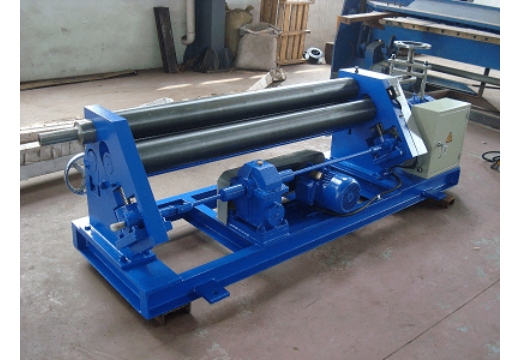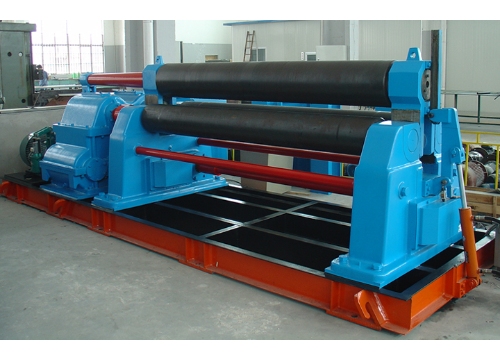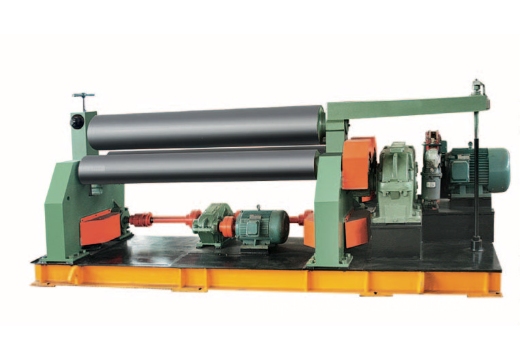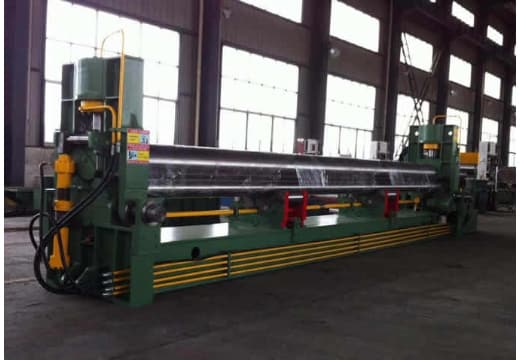Analysis of Types of Three-Roll Plate Bending Machines
Three-roll plate bending machine
Three-roll plate bending machines are available in mechanical and hydraulic variants: Mechanical three-roll plate bending machines are categorised as symmetrical and asymmetrical. Mechanical three-roll symmetrical plate bending machine: Performance characteristics of the mechanical three-roll symmetrical plate bending machine: This machine adopts a symmetrical three-roll configuration. The upper roll performs vertical lifting motion at the symmetrical position between the two lower rolls, achieved through lead screw-nut and worm gear transmission. The two lower rolls rotate via the output gear of the reduction gearbox meshing with the lower roll gear, providing the torque required for plate rolling. A drawback of this machine is that plate ends require pre-bending using other equipment.
Mechanical Three-Roll Asymmetric Plate Bending Machine
Key Features of the Mechanical Three-Roll Asymmetric Plate Bending Machine: This machine adopts a three-roll asymmetric configuration. The upper roll serves as the primary drive, while the lower roll performs vertical lifting motion to clamp the plate. It engages with the upper roll gear to function as the main transmission mechanism. The side roll performs tilting and lifting motion, providing dual capabilities for pre-bending and full-circle rolling. Compact structure, convenient operation and maintenance.
Hydraulic Three-Roll Plate Bending Machine
Hydraulic Three-Roll Symmetrical Plate Bending Machine Key Features: The upper roll is vertically adjustable via hydraulic transmission, with vertical movement achieved through hydraulic fluid acting upon the piston rod within the hydraulic cylinder. The lower roll is rotationally driven by meshing gears from the reduction gearbox output, providing the torque for plate bending. Adjustable support rollers are fitted beneath the lower roll. The upper roll adopts a drum-shaped design to enhance workpiece straightness, making it suitable for ultra-long specifications and various cross-sectional tank shapes. As an upward-adjusting symmetrical three-roll plate bending machine, it can form metal plates into circular, arcuate, and conical workpieces within specified ranges. In this model, both lower rolls serve as drive rolls, while the upper roll functions as a driven roll. It is widely employed in shipbuilding, boiler manufacturing, aerospace, hydroelectric power, chemical engineering, metal structures, and mechanical engineering industries. Suitable for bending and deforming metal plates, it can roll circular, arc-shaped and conical workpieces within a certain range, and features a plate end pre-bending function. This model has two driven lower rolls that can move horizontally, while the upper roll is a driven roll that can move vertically. Movement can be achieved mechanically or hydraulically, with all drive shafts connected via universal joint couplings.
Mechanical Three-Roll Symmetrical Plate Bending Machine
Mechanical Three-Roll Symmetrical Plate Bending Machine Performance Characteristics: This machine adopts a three-roll symmetrical configuration, with the upper roll performing vertical lifting motion at the symmetrical position between the two lower rolls. This motion is achieved through screw-nut and worm gear transmission. The two lower rolls rotate, driven by the output gear of the reduction gearbox meshing with the lower roll gears, thereby providing the torque required for plate rolling. A drawback of this machine is that the plate ends require pre-bending using other equipment.
Mechanical Three-Roll Asymmetric Plate Bending Machine
Key Features of the Mechanical Three-Roll Asymmetric Plate Bending Machine: This machine adopts a three-roll asymmetric configuration. The upper roll serves as the primary drive, while the lower roll performs vertical lifting motion to clamp the plate. It engages with the upper roll gear to function as the main transmission mechanism. The side roll performs tilting and lifting motion, offering dual capabilities for pre-bending and full-circle bending. Compact structure, convenient operation and maintenance. Technical Specifications: Model/Specification Maximum Plate Thickness (mm) Roll Diameter (mm)
Hydraulic Three-Roll Symmetrical Plate Bending Machine
Hydraulic Three-Roll Symmetrical Plate Bending Machine Key Features: The upper roll is capable of vertical lifting, with hydraulic transmission for this vertical movement achieved through the action of hydraulic oil within the cylinder acting upon the piston rod. The lower roll is rotationally driven via gear meshing from the output of the reduction gearbox, providing the torque required for plate bending. The lower roll incorporates adjustable support rollers at its base. The upper roll adopts a drum-shaped profile to enhance the straightness of the finished product, making it suitable for forming extra-long tanks of various cross-sectional shapes.
 Analysis of Types of Three-Roll Plate Bending Machines
Analysis of Types of Three-Roll Plate Bending Machines
 A world of difference! The distinction between three-roll and four-roll plate bending machines
A world of difference! The distinction between three-roll and four-roll plate bending machines
 Working Principle and Structural Features of the Top-Roll Universal Plate Bending Machine
Working Principle and Structural Features of the Top-Roll Universal Plate Bending Machine
 The primary functions of a plate rolling machine
The primary functions of a plate rolling machine

